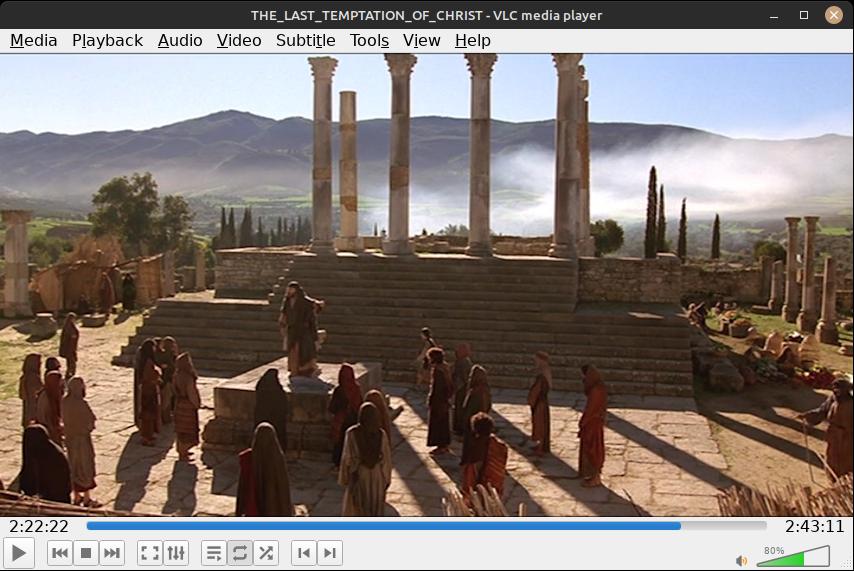
Baths, Toilets, and Drains of Volubilis
Plumbing of Volubilis, a Berber-Roman city in today's northern Morocco
Volubilis
was founded by the Berber people of northwestern Africa.
It probably functioned as the capital of the
Kingdom of Mauretania, in today's northern Morocco.
Juba II ruled the Kingdom of Mauretania from 25 BCE to
his death in 23 CE.
He had connections.
His first wife was the daughter of Cleopatra and Marc Antony,
and Rome had installed Juba at Volubilis as their client-king.
Mauretania became two Roman provinces in 44 CE:
Mauretania Caesariensis, in today's northern Algeria,
and Mauretania Tingitana, in today's northern Morocco.
The second of those was named for its capital Tingis,
now Tangier.
Commercial ports along the coastline had been
trading with Carthage since before the 4th century BCE.
Berber tribes had controlled the interior
since the time of the Late Bronze Age Collapse around
1200–1150 BCE.
Volubilis was on the extreme southwestern fringe of
the Roman Empire.
Much of Mauretania was reconquered by Berber tribes
after the Imperial Crisis of the Third Century.
Christianity spread to parts of Mauretania in the
third century CE,
but it was mostly confined to the port cities in the east.
The interior kept the Romano-Berber religion,
which had been influenced by ancient Egyptian,
Punic, and Phoenician beliefs.
Volubilis is at the edge of some mountains,
overlooking a broad and fertile agricultural plain
that has been settled since the late Neolithic,
about 5,000 years ago.
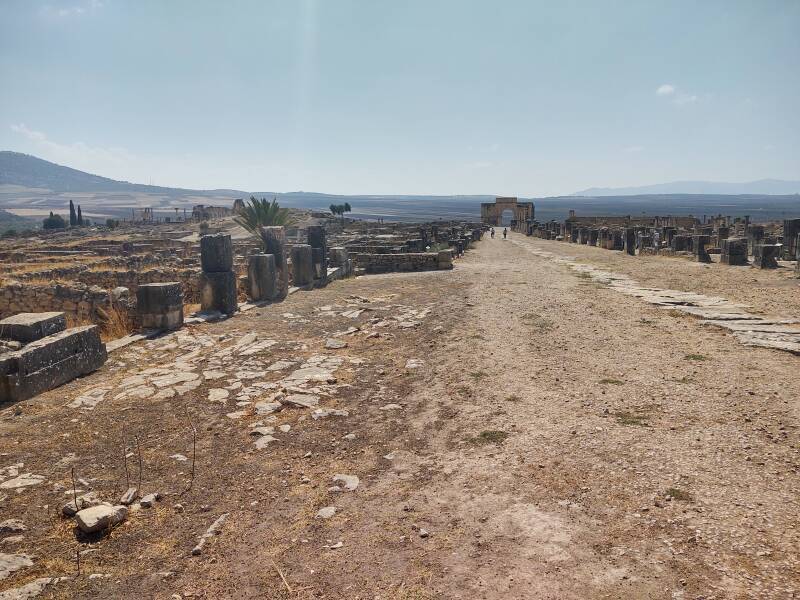
Gallien Baths
The Thermes de Gallien or the Gallienus Baths are at the center of the city, next to the central temple and the basilica where government officials worked. The term "basilica" was repurposed for a specific category of Christian church in later centuries. It was the largest and most lavish of the baths in Volubilis.
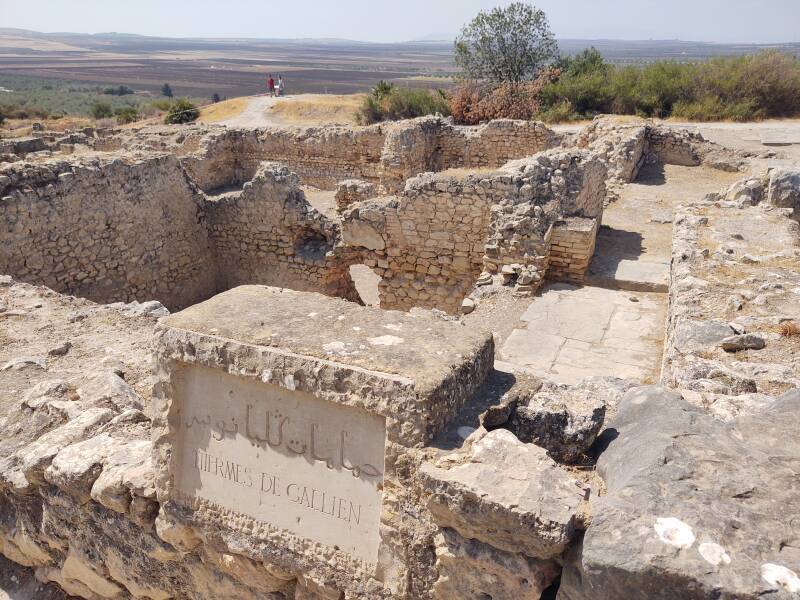
The site is well described by maps at different scales.
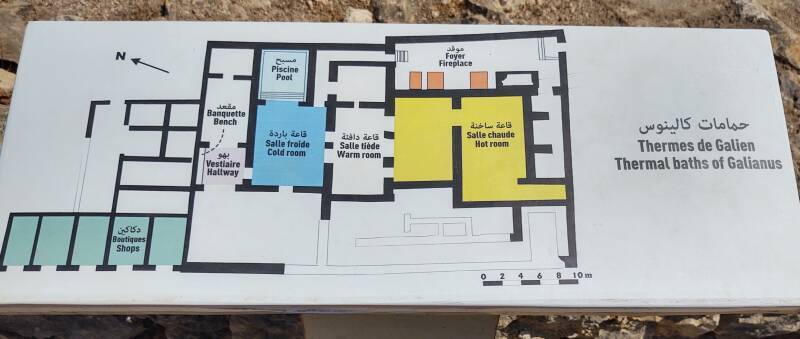
Below is the furnace area of the baths, with a prominent drain line.
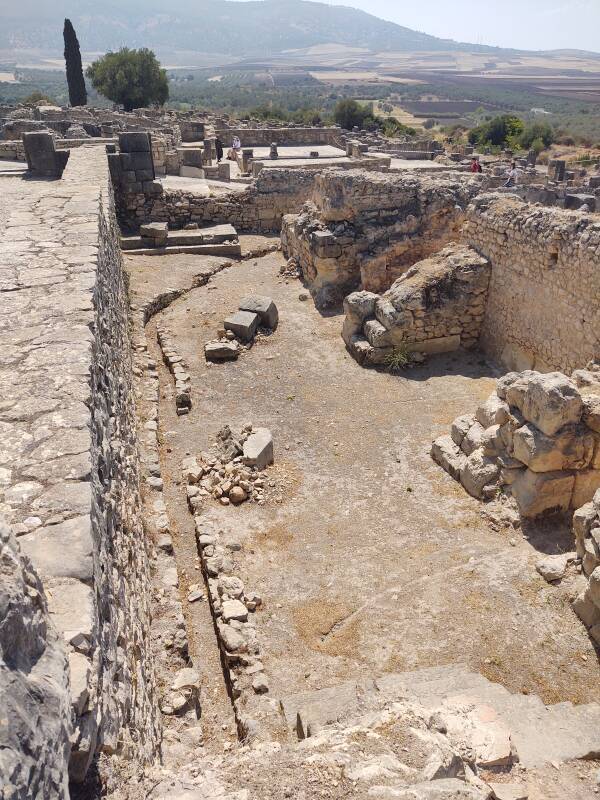
Here we're looking through the Cold Room toward the Pool. The building in the background contains a large olive press. The wealth of the city largely came from olives, especially their oil which was pressed out and collected in facilities throughout the city.
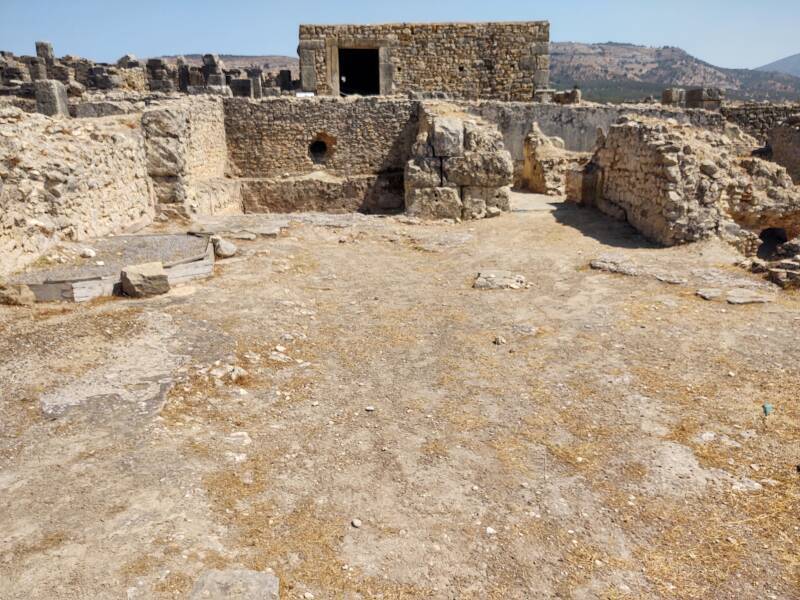
The Pool would have been quite cool as it was at one end of the Cold Room.
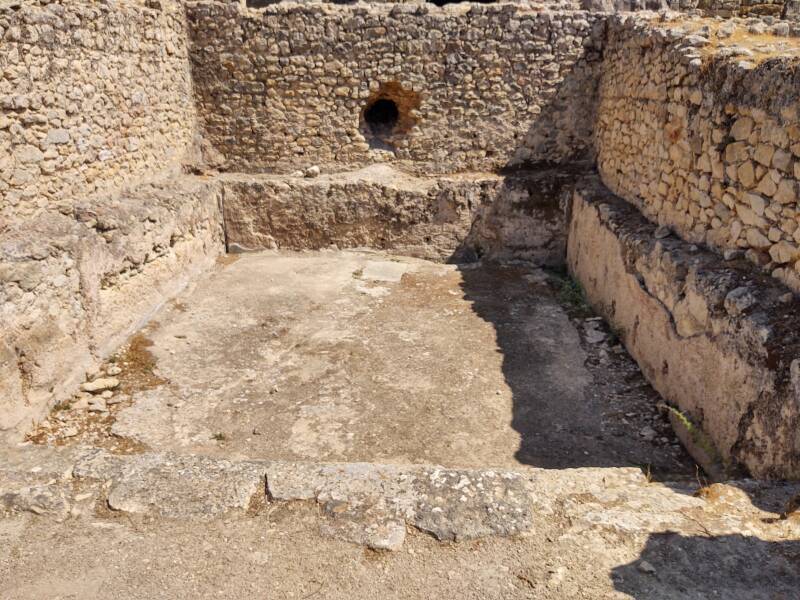
The Warm Room is adjacent to the Cold Room. Bathers would have made their way from Cold to Warm to Hot and back again.
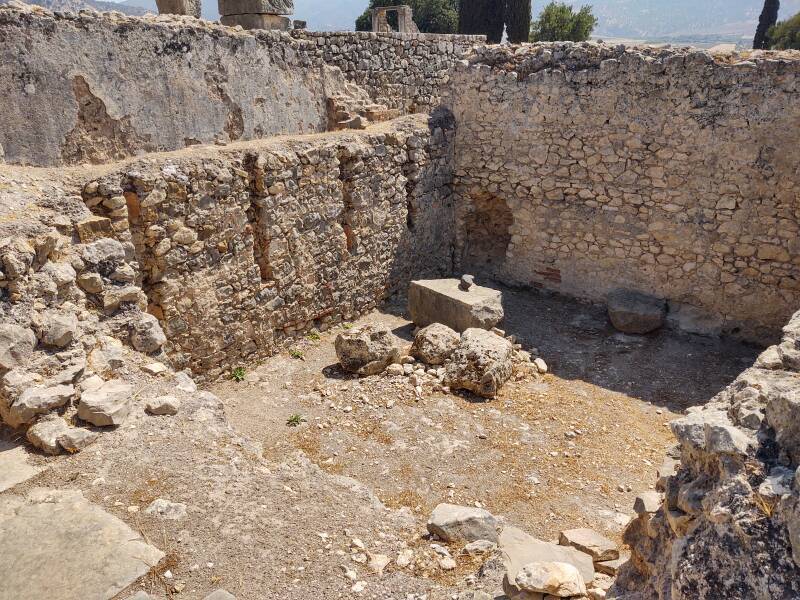
The Hot Room of the Gallien Baths is quite large. Here you can see some of the surviving technology. Hot water was channeled under a raised floor.
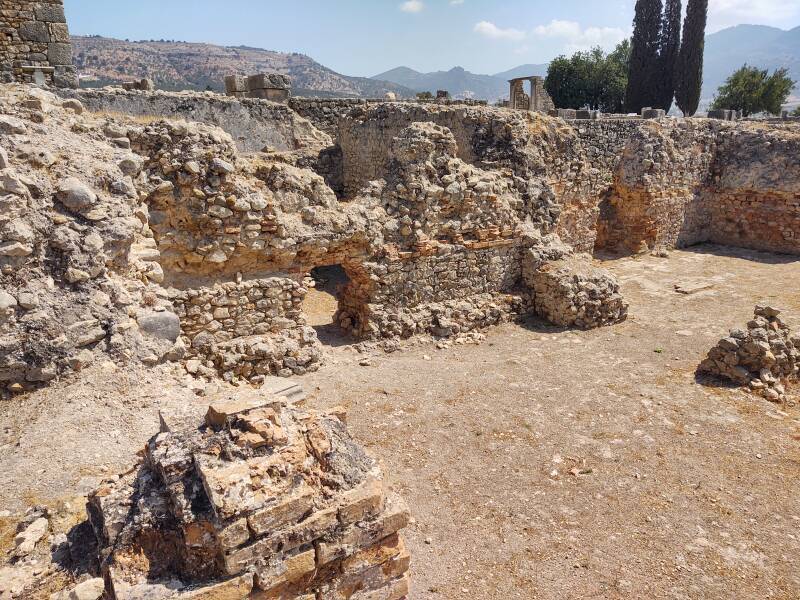
This view is from the southwest corner of the Hot Room toward the furnace area and that olive press.
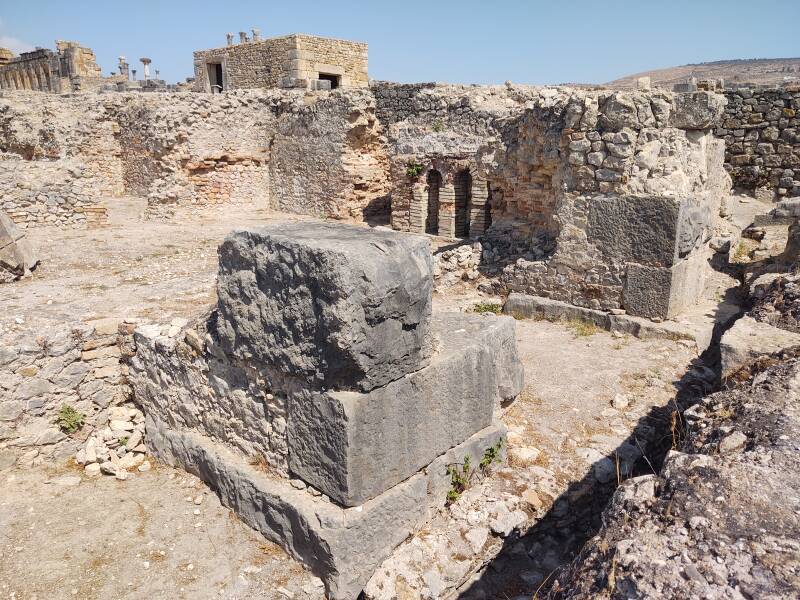
The baths are surrounded by water channels and other infrastructure.
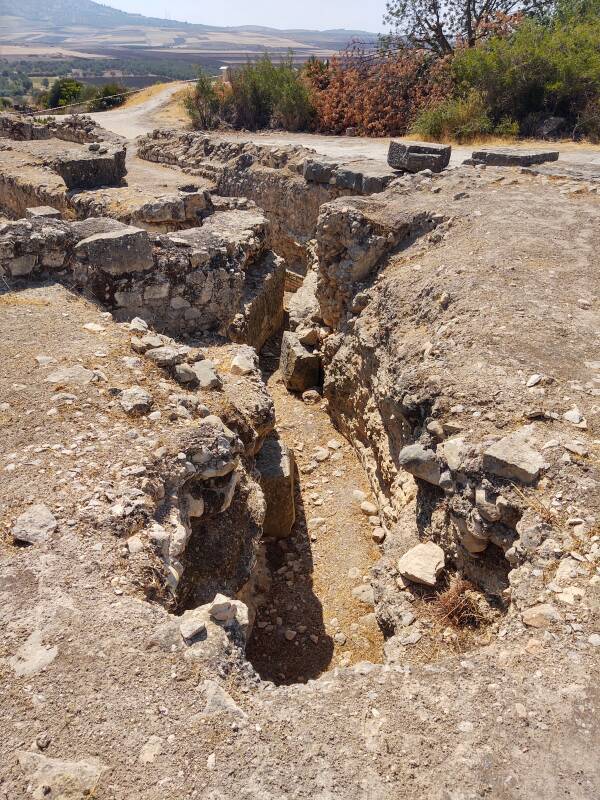
House of Orpheus
The House of Orpheus is named for a large mosaic of that Greek deity said to have traveled with Jason and the Argonauts. He is pictured here in the usual way, wearing a Phrygian cap, playing his lyre, and attracting many species of animals and birds.
Here's the view from the northeast corner, looking to the west. Immediately in front of us is the large private bath. Some of the original floor remains with its mosaics. The floor is gone from much of the bath, exposing the arches that supported it above the hot water.
Beyond the house is another olive press complex, and then a slope down to the agricultural plain.
The large public Gallien Baths are right across a small street, to the right in the first picture below. But who wants to bathe with the proletariat if you can afford your own lavish private bath?
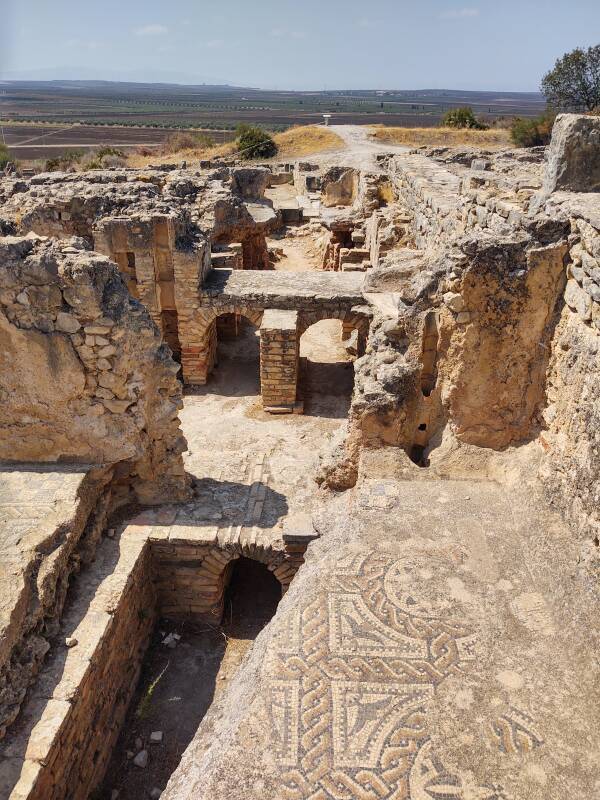
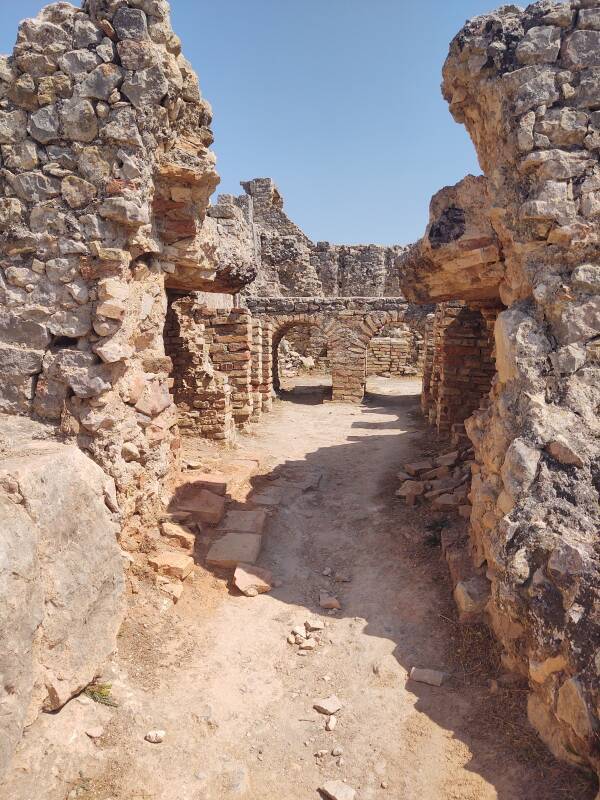
The second picture above is the reverse view of the first, down at hot-water-level looking back through the bath.
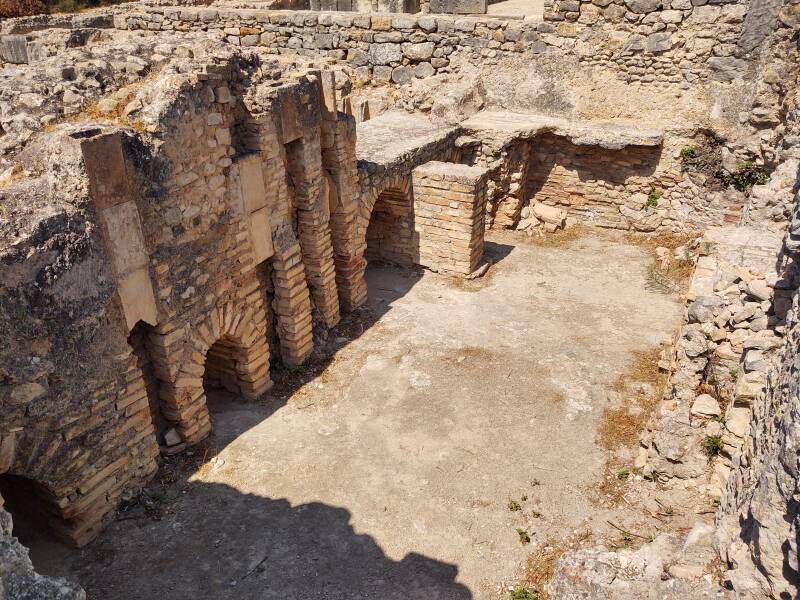
The public bath is just across the narrow street at left in the background.
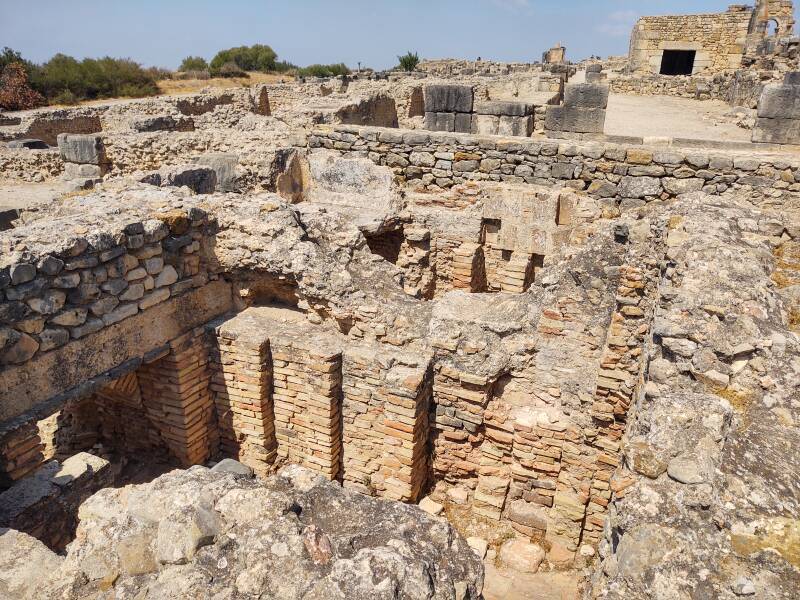
The map shows that this house's private bath was about 16×13 meters in size. To its upper right in this picture are two rooms, one with a large water basin about four meters square.
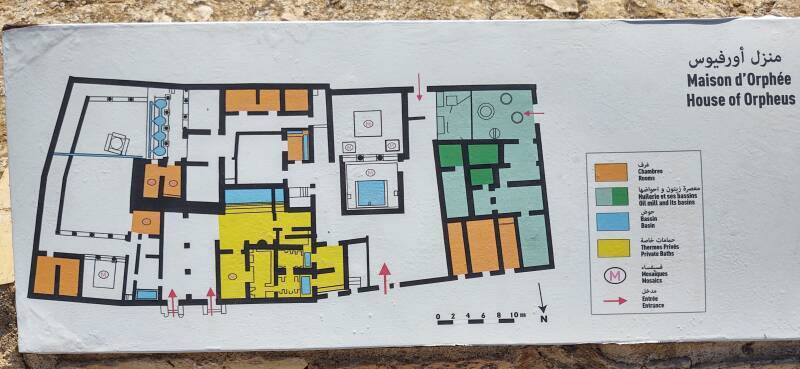
Those two large rooms hosted parties. The triclinum at left had benches around three of the walls. Guests could recline, eat and drink, and admire the mosaic in that room. They could also see through the columns to the connecting room at right, which had a smaller mosaic and a large rectangular water basin.
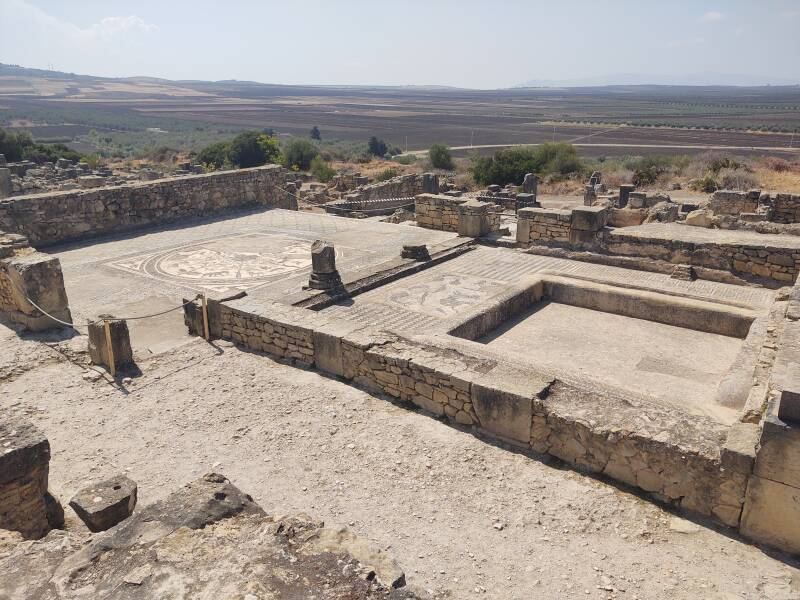
Wealthy Romans built basins, fountains, and other water features in large homes, especially so in Volubilis. This room would have had benches along the two sides for further lounging, eating, drinking, and admiration of the design and decorations.
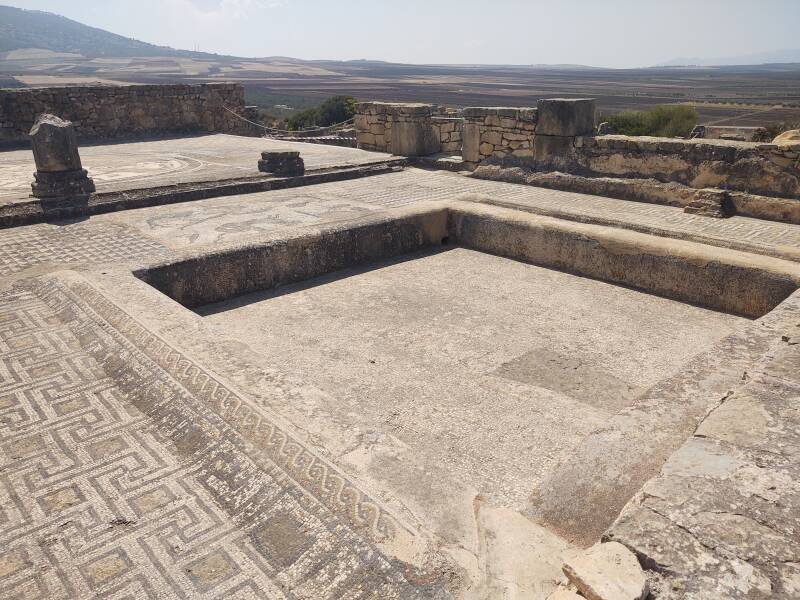
Here is the mosaic of Orpheus. Art historians have commented that it isn't as well done as many of the examples from the period. That's Orpheus at the center, surrounded by animals that he supposedly has attracted with his music. However, the mosaic doesn't really tie the room together. The animals don't seem very entranced by the music, as they're facing in all different directions. And, they're rendered in different scales with birds nearly as large as the elephant. The artist may have copied pieces of different mosaics with no real plan for overall harmony.
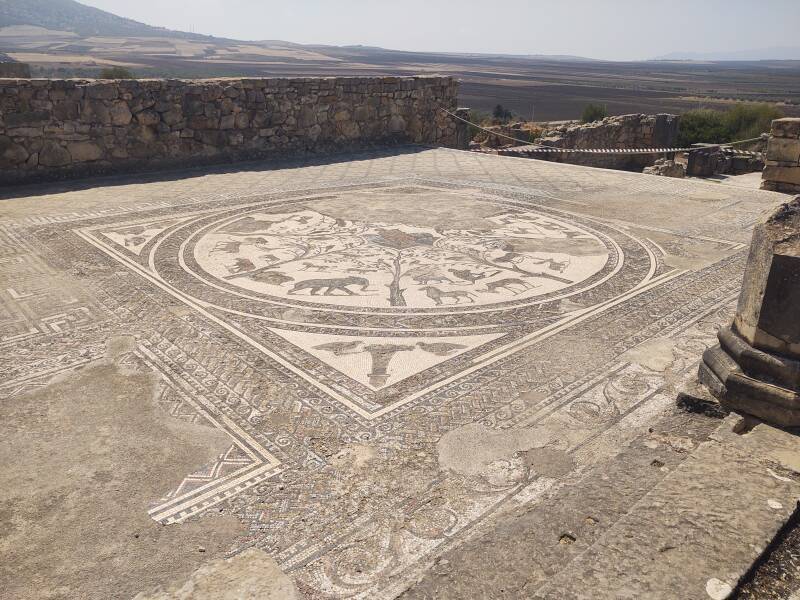
And where is the bathroom, you ask? Right here.
This multi-person latrine is just off the two large rooms. Guests wouldn't have far to go from the lounging area to the toilet.
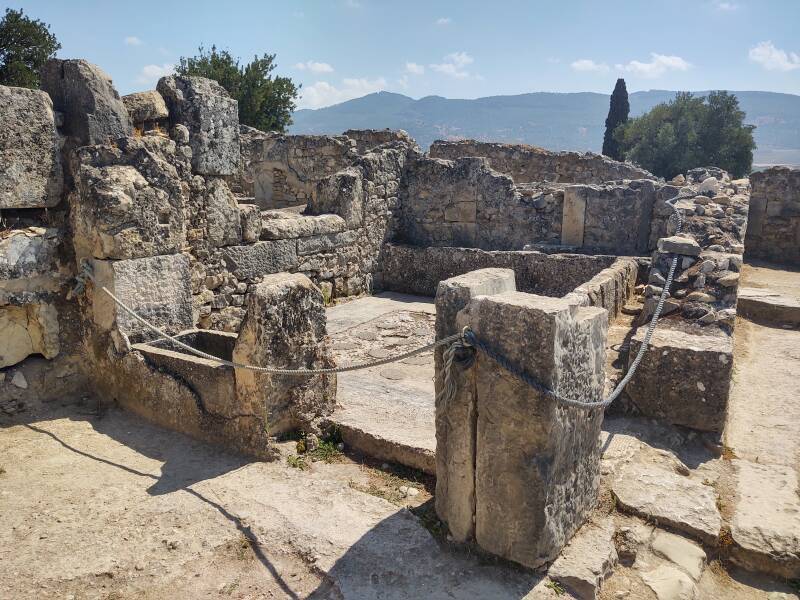
Seats above a flushing water channel along the wall at right and the far wall could easily seat a dozen people at once.
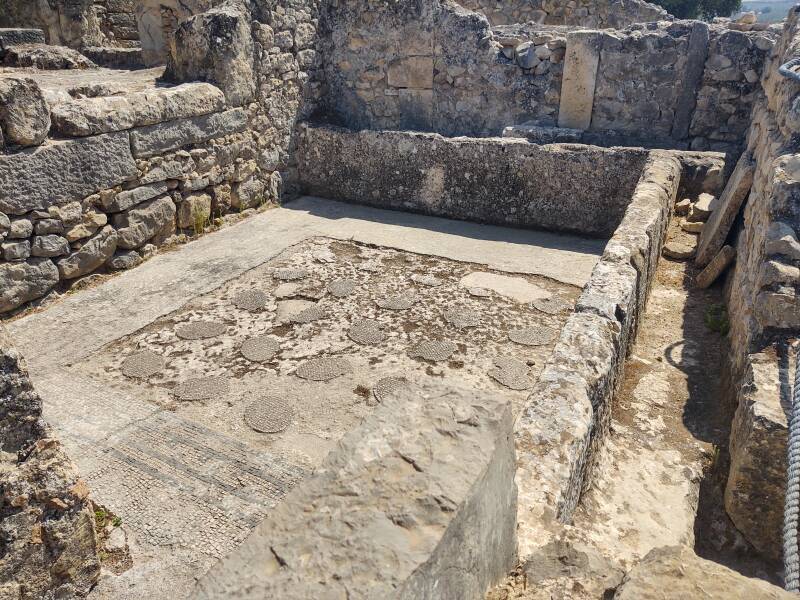
There would have been a channel in the floor running past everyone's feet. The Romans, at least the higher classes, used a tersorium, also called a xylospongium, a sponge mounted on a stick. The sponge could be dipped into a water channel running in front of the communal row of seats in the latrine, and rinsed off in that channel after use. If there was no channel of running water, a bucket of salt water or vinegar water would be used, as Seneca described in his Letters of Lucillus [70,20].
If neither a tersorium nor water were available, the Greeks and Romans used πεσσοι or pessoi, small stones, to clean themselves. The tradition started with the ancient Greeks that three stones should be enough to finish the job. This convention has been very long lived, with a hādīth attributed to Muhammad specifying three stones as the ideal number for anal cleaning. The pessoi were also used in an ancient board game in Greece. Aristophanes wrote a scene involving pessoi in Peace in the 5th century BCE. Here's the Penguin Classics translation:
Arms dealer [displaying a cuirass]: And what, alack, shall I do with this rounded cuirass, a beautiful fit, worth ten minas?
Trygaeus: Well, that one will not make a loss for you, anyway. Give me that at cost price. It will be very convenient to crap in ...
Arms dealer: Stop this impudent mockery of my goods!
Trygaeus [placing the cuirass on the ground like a chamber pot and squatting on it]: Like this, if you put three stones beside it. Is it not clever?
The Greeks would use όστρακα or ostraka, small pieces of broken ceramic goods, to vote to shun or ban their opponents. This is where we get the word ostracize. Some scholars have suggested that the ostraka could be used as pessoi, literally wiping your feces onto the names of hated individuals. The abrasive characteristics of broken ceramic material suggest that long-term used of these as pessoi could have resulted in localized irritation at the least, progressing to skin or mucosal damage or the irritation of external hemorrhoids. For more on toilet use of pessoi and ostraka and the medical implications see the paper "Toilet hygiene in the classical era", Philippe Charlier, Luc Brun, Clarisse Prêtre, and Isabelle Huynh-Charlier, in BMJ (the British Medical Journal) 2012, pages 345-346.
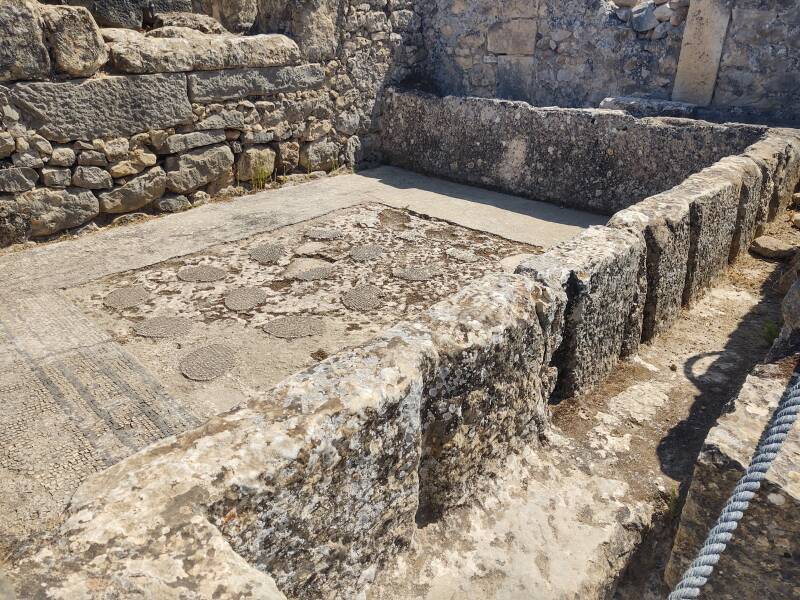
A rectangular stone basin at one corner would have held water for rinsing the tersorium or xylospongium.
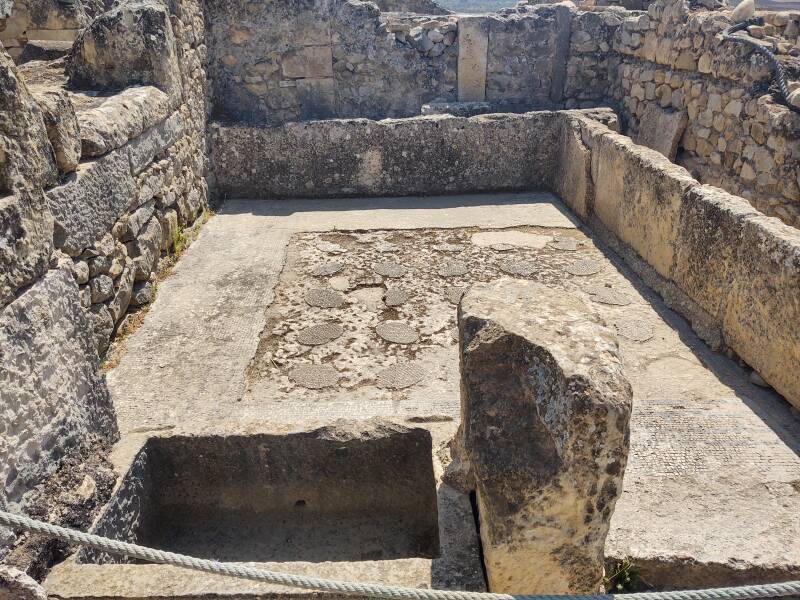
City Center
The Capitoline Temple was dedicated to Jupiter, Juno and Minerva, the three chief divinities of the Roman state. Civic assemblies were held here to ask the gods for help, or to thank them for successes in major undertakings such as wars.
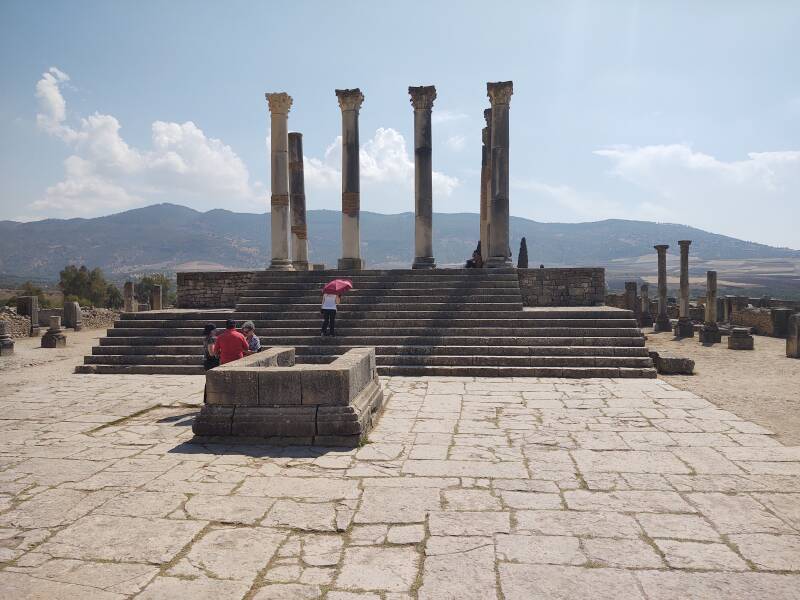
Looking in the opposite direction from the top of the temple steps, you look over an altar where public offerings would be made.
Beyond that is the basilica, where city government and justice went on. The basilica is a little over 42 by 22 meters. Basilica is an architectural term, coming from the Greek βασιλική στοά or royal stoa. Basilicas were standard public buildings in Roman cities. The basilica with its central nave with two or more parallel aisles under a two-level roof became the standard model of Christian churches after the early third century CE.
The city magistrates sat in apses at either end of the basilica. One long side, to our left here, overlooked the forum where markets were held, with small temples and public offices lining its perimeter and statues of Emperors and local dignitaries standing on now-empty plinths.
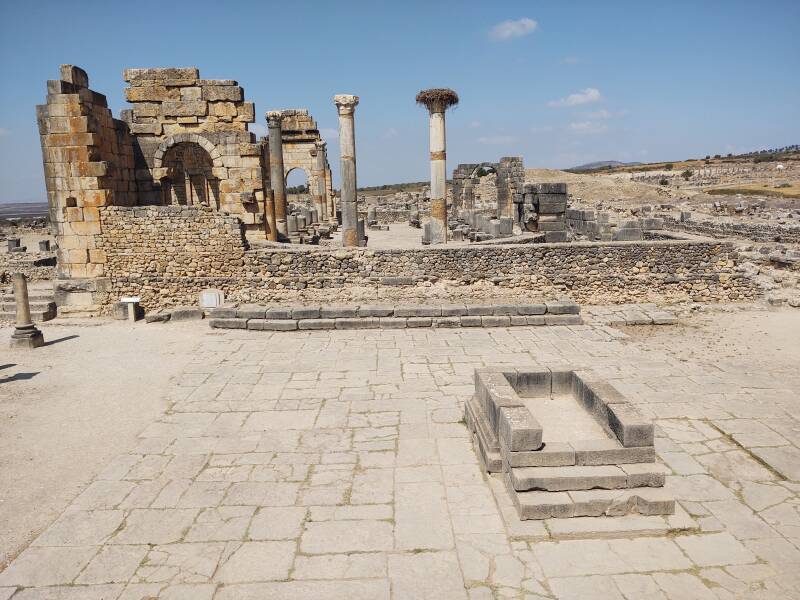
Morocco has a busy film industry, making movies for local production and also hosting foreign productions. Martin Scorcese's 1988 The Last Temptation of Christ was entirely filmed in Morocco, with some scenes filmed at Volubilis. Here's Harry Dean Stanton playing Saul of Tarsus preaching to the people around that altar.
The triumphal Arch of Caracalla stands nearby. It's at the lower end of the Decumanus Maximus, the main street through the city.
The city's governor commissioned this arch in 217 to honor the Emperor Caracalla and his mother Julia Domna. Caracalla was of North African and Arab descent. His father was Septimius Severus, from Leptis Magna, today's Khoms, Libya. His mother was from Emesa, today's Homs, Syria.
Caracalla had issued an edict in 212 declaring that all free men in the Roman Empire were to receive full Roman citizenship. That included all the free men of Volubilis, hence the arch. Caracalla and his mother were assassinated by an usurper before the arch was finished, so it didn't lead to further benefits for the city.
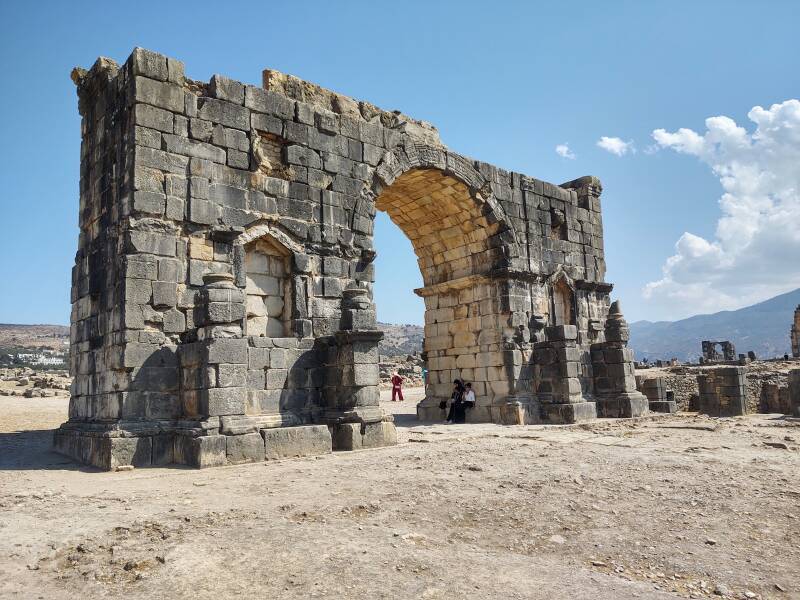
Large Houses with Pools and Fountains
The district to the northwest of the broad street of Decumanus Maximus contained many large houses, many of them with elaborate water basins and fountains.
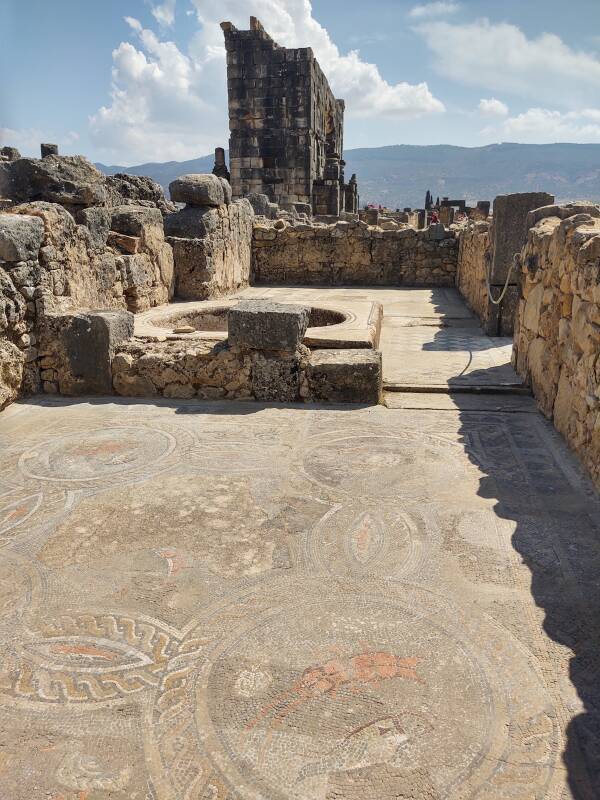
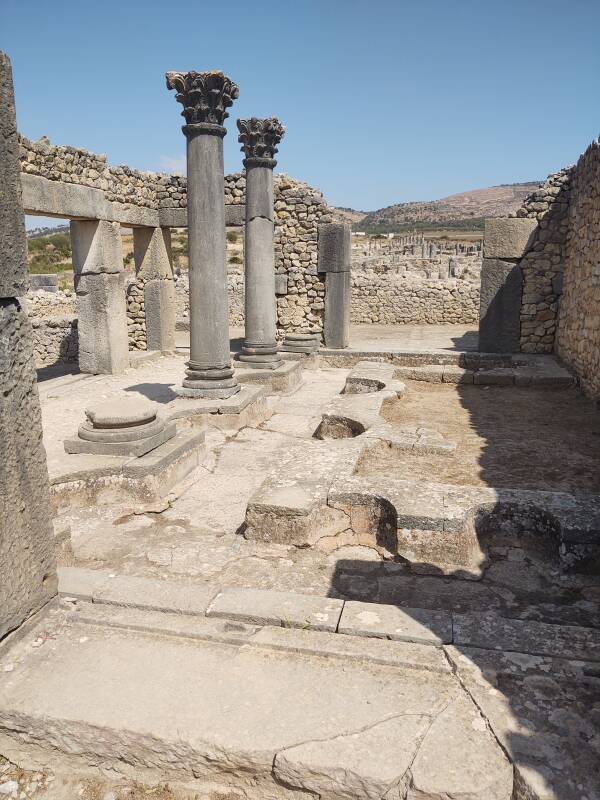
We don't know the names of people who lived in these grand basin-filled houses, so they get descriptive names. Such as the House of Columns seen above and below.
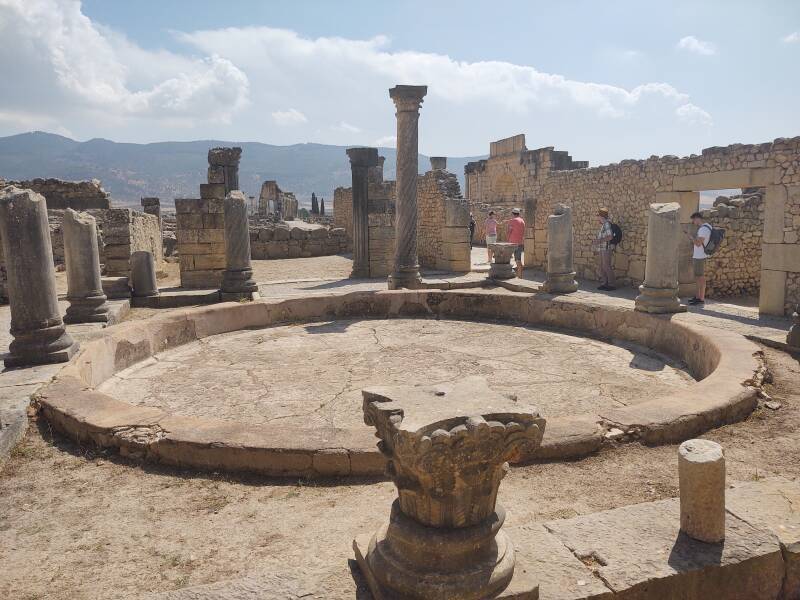
Those with distinctive mosaic floors usually get their names from that. Below is a large water basin in the House of the Labors of Hercules, where one room's floor depicts that story.
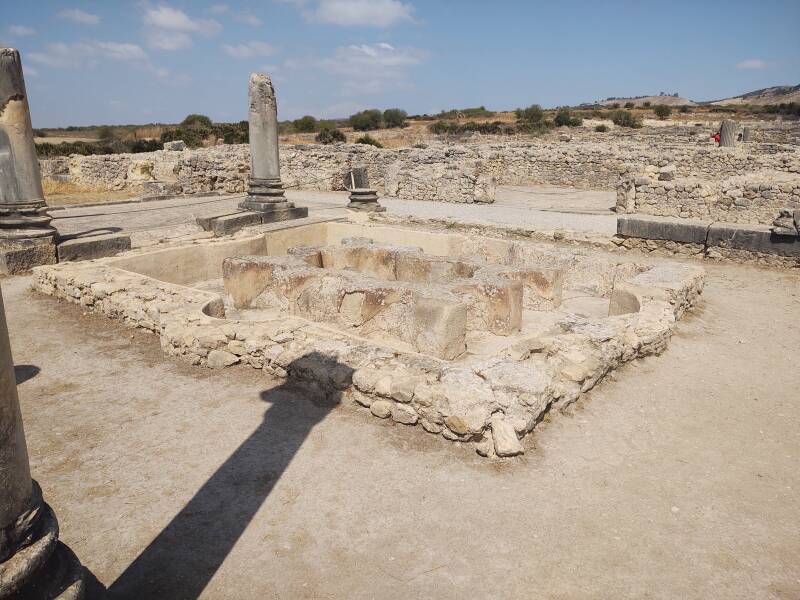
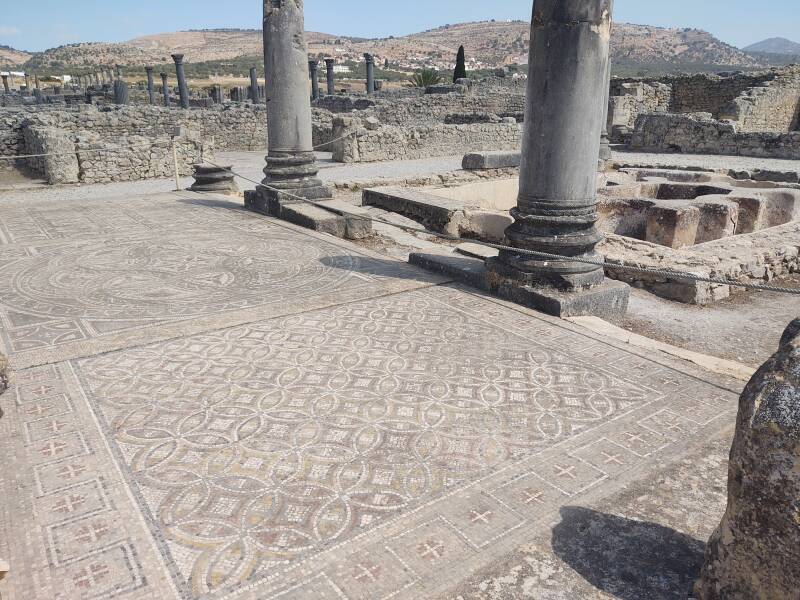
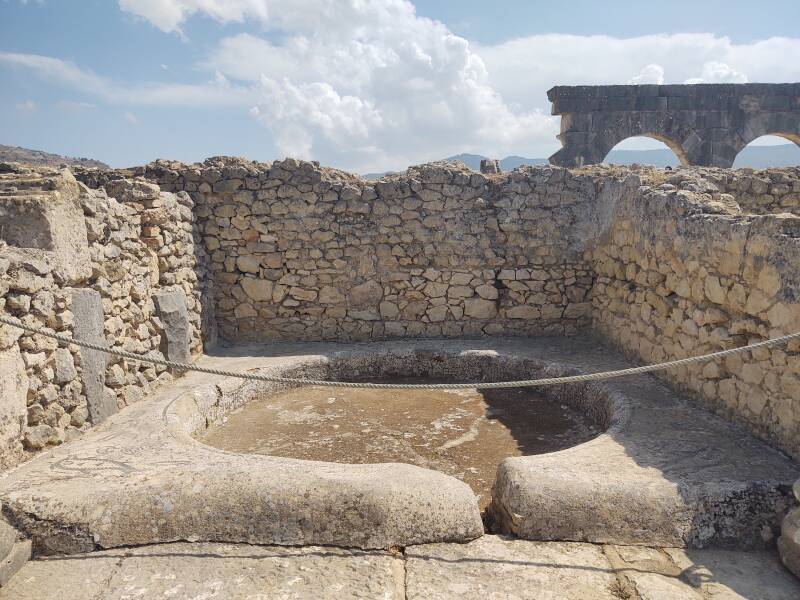
Here's the mosaic showing the Labors.
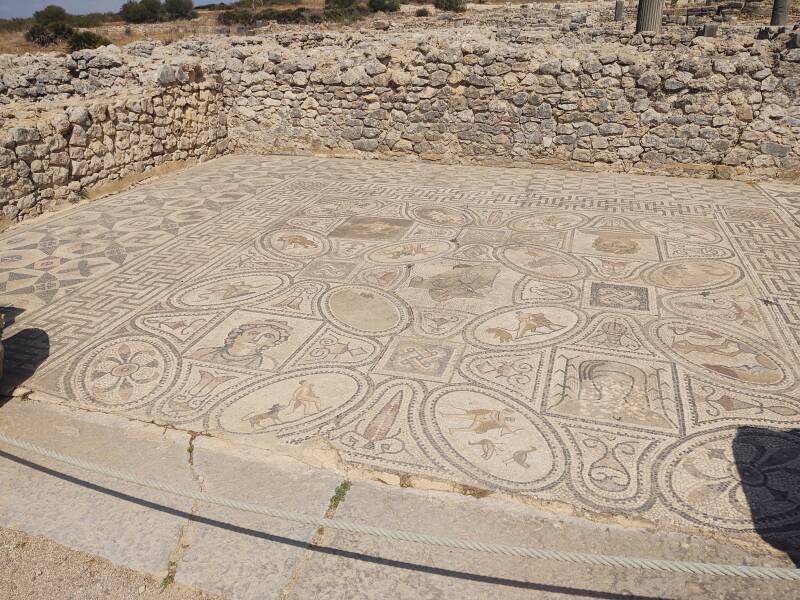
The nearby House of the Bathing Nymphs had a large rectangular basin surrounded by columns which I assume supported a roof. That way you could sit on the low surrounding wall between the columns and watch the water ripple.
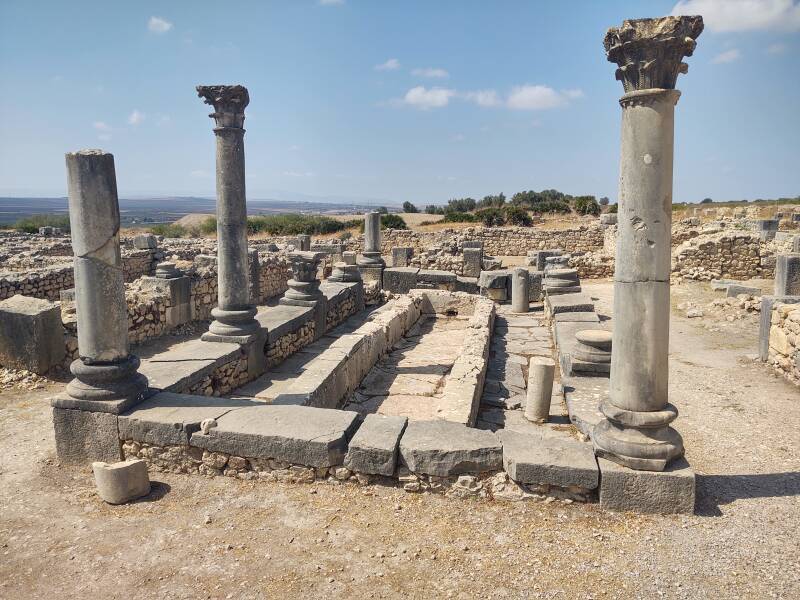
Those bathing nymphs make an appearance.
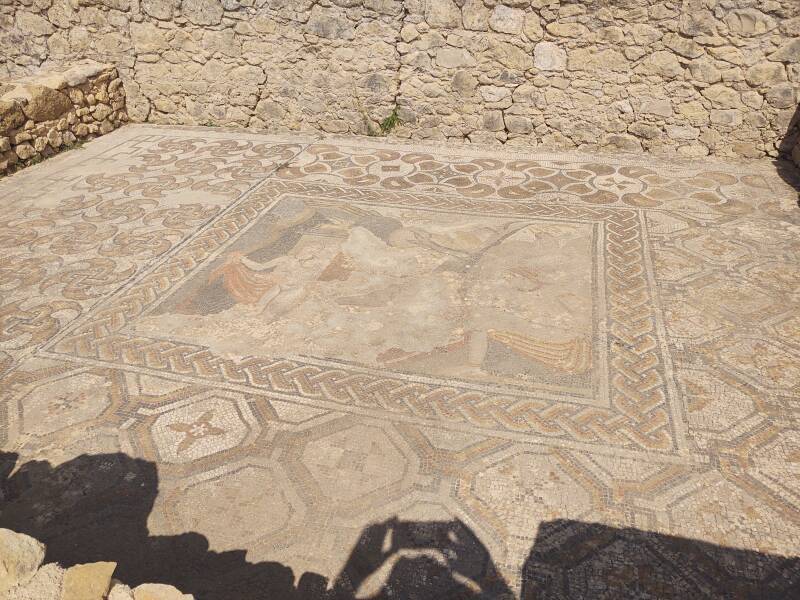
Nearby in (I think) the House of Dionysus you can find a poorly restored latrine.
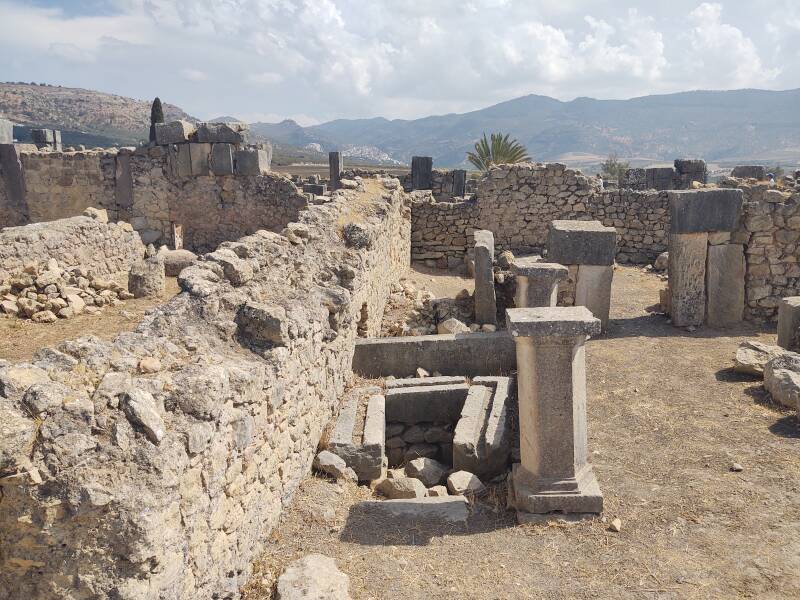
There's the water channel around three sides. However, the surrounding walls are jammed in too tight. There would have been bench seats around the left, far, and right sides, with a flushing water channel underneath the benches. There's no room for the flushing channel or the seat on the left side.
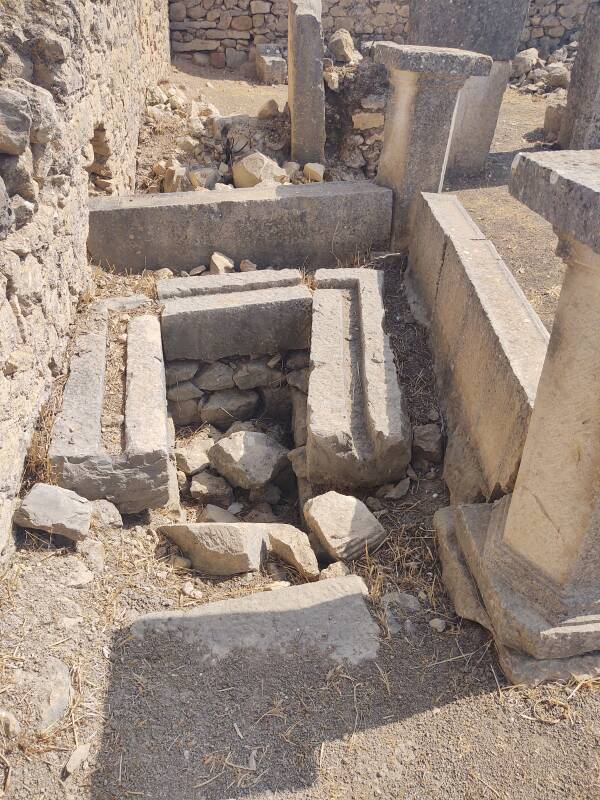
Aqueduct
An aqueduct brought water to Volubilis from the mountains to the north. Since most visitors aren't especially interested in hydrological infrastructure, there are no prominent markings. It's up to the more intrepid visitor to hunt it down.
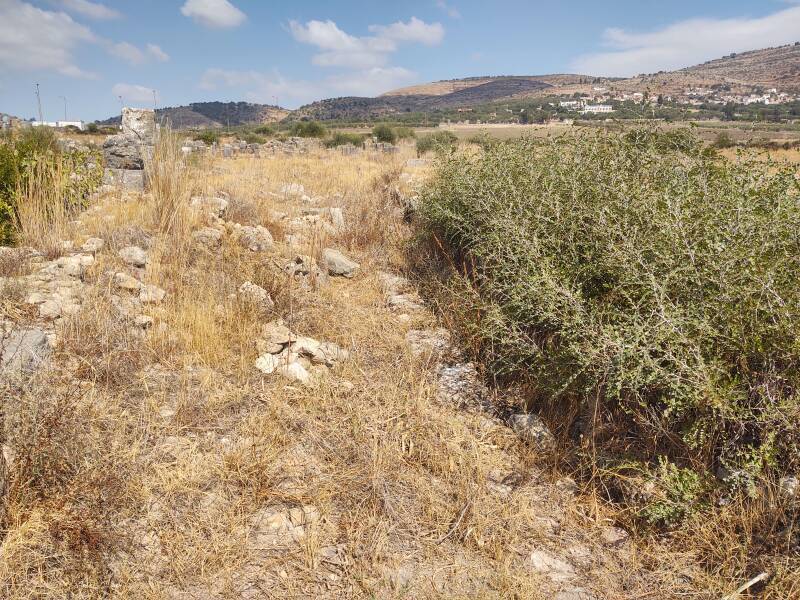
The aqueduct runs roughly parallel to Decumanus Maximus, beside a prominent street one block to its east.
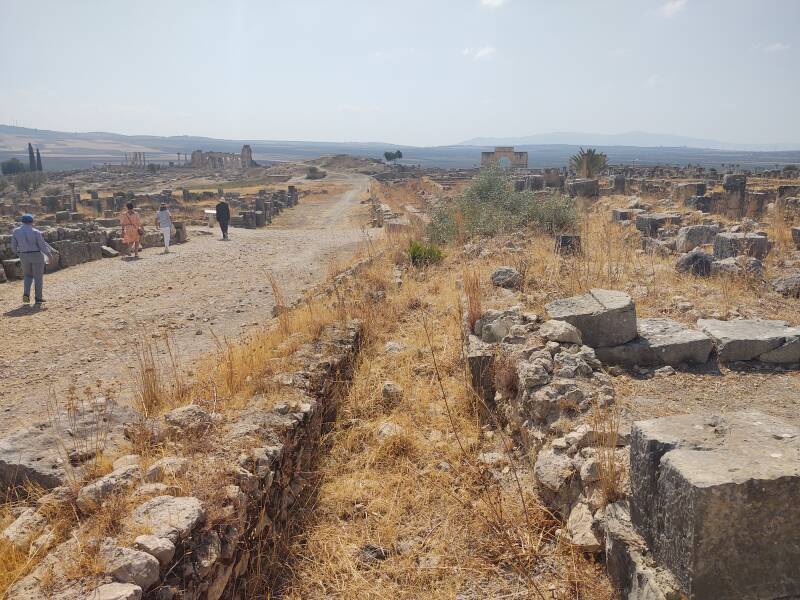
There are also drains to be discovered today.
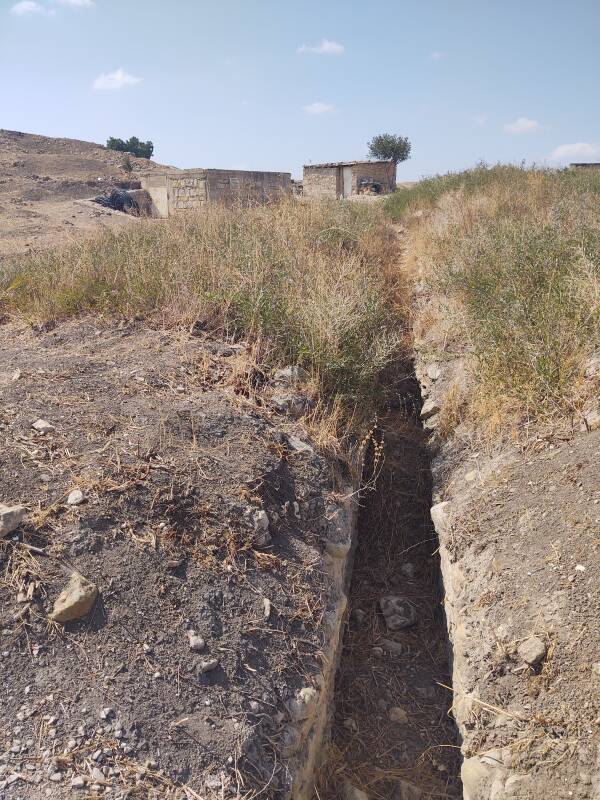
Local Berber tribes captured Volubilis around 285 CE. Rome didn't try to retake the city, because it was out on the southwestern fringe of the Empire, distant and difficult to defend.
The city was inhabited for at least another 700 years. It was a locally prominent Christian community, and then became home to an early Islamic settlement.
Idris ibn Abdallah, later known as Idris I and Moulay Idris, had backed the losing side, the pro-Shi'a rebels, in a battle near Mecca in 786 CE. He needed to immediately get out of the Abbasid Caliphate's territory, and fled west all the way across North Africa to the site of Volubilis. When he arrived there some Berbers and a few Judeo-Christian people living in the ruins.
Idris made an alliance with the local Berber tribe in 789, and used that alliance plus his status as a sharīf, a descendant of the Prophet Muhammad, to quickly become the region's most powerful religious and political leader. He was Morocco's first major Muslim ruler.
Volubilis, as you can see in these pictures, overlooked an open plain with very limited defensive structures. Idris led the people to abandon Volubilis and build a new settlement in the nearby mountains, probably roughly where today's town of Moulay Idris Zerhoun stands.
Idris had fled civil war in Arabia. That past caught up with him five years later. He died in 791, very likely poisoned by an assassin sent by Harun al-Rashid, the Abbasid Caliph in Baghdad.
By the 11th century the seat of power had been relocated to Fez and Volubilis was abandoned. The ruins were mostly ignored and left intact until a mid-18th century earthquake struck. Then Volubilis began to be looted by Moroccan rulers using it as a quarry of pre-cut stones useful to build the nearby city of Meknès.
In the late 1800s the site was identified as the ancient city of Volubilis. About half of the site was excavated during the French Protectorate.
